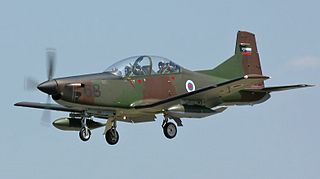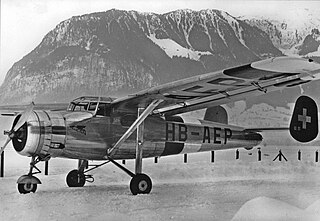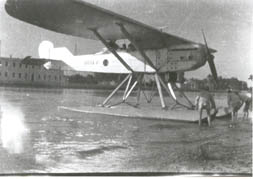
The Pilatus P-2 is a trainer aircraft designed by Swiss manufacturer Pilatus in 1942 and first flown on April 27, 1945. It was used by the Swiss Air Force from 1946 until 1981. The Pilatus P-2 emerged from an unbuilt project of the Pilatus P-1, which can be seen as a single-seat version of the P-2.

The Aermacchi AM.3 was the result of a joint venture between Aermacchi and Aeritalia in response to an Italian Army requirement for an aircraft to replace the Cessna L-19, and was initially designated the MB-335.

The Pilatus PC-9 is a single-engine, low-wing tandem-seat turboprop training aircraft manufactured by Pilatus Aircraft of Switzerland. Designed as a more powerful evolution of the Pilatus PC-7, the PC-9's first flight was made in May 1984 after which certification was achieved in September 1985. After this, the first production orders for the type were received from the Royal Saudi Air Force, with deliveries commencing in 1985. Since then, more than 250 airframes have been produced across five different variants, and the type is employed by a number of military and civilian operators around the world, including the Swiss Air Force, Croatian Air Force, Royal Thai Air Force and the Irish Air Corps

The Pilatus SB-2 Pelican was a civil utility aircraft developed by a purposely founded development bureau at the ETH Zurich on behalf of the Federal Air Authority. In November 1940 it was decided to go on with the project and build the aircraft, in February 1941 the Authority approved the development bureau to have it built at the newly formed Pilatus Aircraft company.

The Piper PA-48 Enforcer is an American turboprop-powered light close air support aircraft built by Piper in the 1970s. It is a development of the World War II-era North American P-51 Mustang fighter. The Enforcer concept was originally created and flown as the Cavalier Mustang by David Lindsay, owner of Cavalier Aircraft, in response to the United States Air Force PAVE COIN program, but Cavalier did not have the manufacturing abilities to mass-produce the Enforcer, so the program was sold to Piper by Lindsay in 1970.

The Beriev Be-30 is a Russian regional airliner and utility transport aircraft designed by the Beriev Design Bureau. It was developed specifically for Aeroflot local service routes using short, grass airstrips. It was also designed to be used in the light transport, aerial survey and air ambulance roles. It competed against the Antonov An-28 and the Czechoslovakian LET-410.

The NDN Firecracker is a single-engine aircraft designed as a military trainer.

ENAER T-35 Pillán is a Chilean propeller-driven basic trainer aircraft. The student and the instructor sit in tandem. Production ceased in 1991 after 7 years but restarted briefly in 1998.

The Breda A.7 was a reconnaissance aircraft developed in Italy for use by the Regia Aeronautica in 1929. It was a braced parasol monoplane of conventional configuration with tailskid undercarriage. The pilot and observer sat in tandem, open cockpits. A single prototype of a long-range example, originally designated A.7 Raid and later A.16 was also constructed, but the air force showed no interest in it.

The Bücker Bü 180 Student was a 1930s German two-seat sporting/training aircraft built by Bücker Flugzeugbau.
The Civil Aviation Department Revathi was a light utility aircraft designed in India principally for use by that country's flying clubs.

The Pilatus P-4 was a Swiss five-seat cabin monoplane designed and built by Pilatus, but had little sales success.

The Malmö MFI-10 Vipan was a four-seat light utility monoplane designed and built in Sweden by Malmö Flygindustri. Only three aircraft were built and the type did not enter quantity production.
The Renard R.30 was a prototype trimotor airliner built in Belgium in 1931. It was a strut-braced high-wing monoplane of conventional design with a fully enclosed flight deck and separate passenger compartment. One engine was mounted on the nose, while the other two were mounted on the leading edges of the wings. Construction was metal throughout, skinned in plywood and fabric.

The ASK 16 was designed by Rudolf Kaiser for production by Alexander Schleicher GmbH & Co of Furth, Germany. The aircraft is of welded tube, wood and fabric construction and has a low-set high-aspect-ratio wing.

The Pilatus PC-8D Twin Porter was a Swiss ten-seat light transport built by Pilatus Aircraft. The type did not go into production and only one was built.

The Pilatus P-1 was a single-engined, single-seat training aircraft project from Pilatus Aircraft in Switzerland, ca.1941.

The Pilatus P-5 was a single-engined artillery observation aircraft project from Pilatus Aircraft in Switzerland.
The OFW OK-15 was a 1950s Austrian two-seat light aircraft. Designed by Otto Kauba and built by the Österreichische Flugzeugwerke GmbH (OFW) at Wiener Neustadt, it was the first aircraft to be designed and built in Austria for 20 years.
The Weber W-151 was a light aircraft built by the Brazilian manufacturer Campanhia Nacional de Aviões.




















